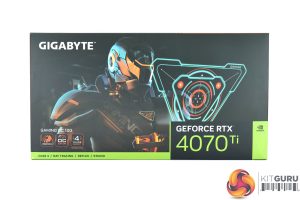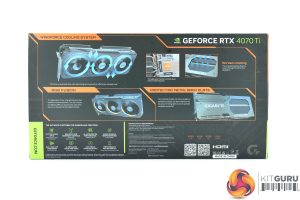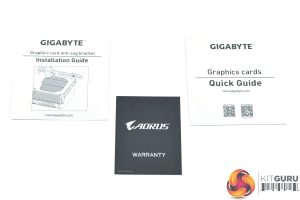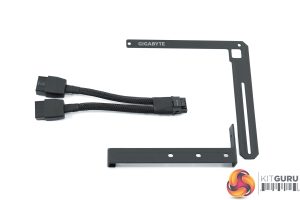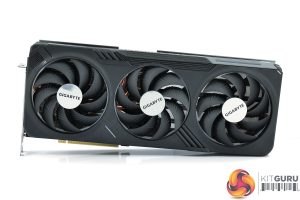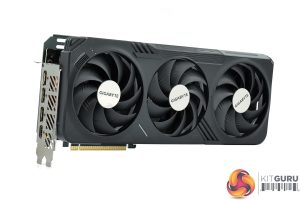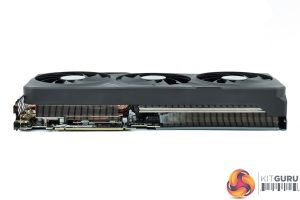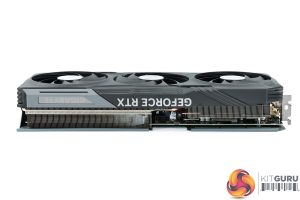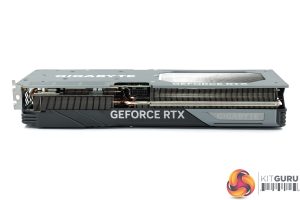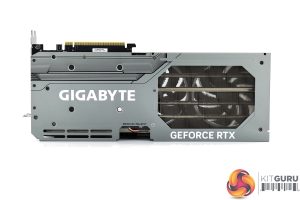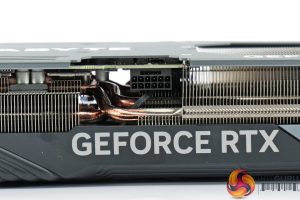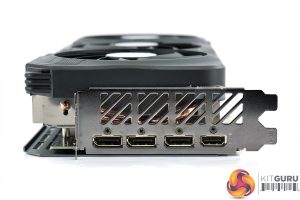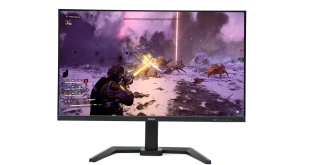The Gigabyte RTX 4070 Ti Gaming OC ships in a black box, with a robotic-style avatar visible on the front. On the back, Gigabyte highlights various key features of the card and cooler design.
Inside we find a few pieces of documentation, alongside a new dual 8-pin power adapter for the 12VHPWR connector. An anti-sag GPU support bracket is also included which screws into a couple of your motherboard stand offs, before attaching to the end of the card to keep it level.
As for the card itself, it's a very similar overall design to the RTX 4080 and RTX 4090 Gaming OC models we have already reviewed, just scaled down slightly. That means we find the same black plastic shroud that's made entirely from plastic. It looks fine but doesn't feel particularly premium in the hand, but it's not the end of the world.
There's also three 100mm fans, using Gigabyte's so-called ‘Unique Blade Fan' design. As expected from a Gigabyte card, the central fan spins in reverse relative to the others, which Gigabyte claims helps to reduce airflow turbulence and therefore increase air pressure down into the heatsink.
This RTX 4070 Ti design is a bit smaller than the 4080/4090 models however. The RTX 4080 version comes in at 343 x 150 x 75mm, whereas the 4070 Ti measures 336 x 140 x 58mm. It's still a big graphics card, no doubt, and it weighs in at a touch over 1.5kg, it's just not quite so monstrous as its higher-end siblings.
The front side of the card is home to the GeForce RTX branding, as well as the Gigabyte logo, one of the RGB zones on the card.
As for the backplate, this is made from metal and while it is a full-length design, there is a large cut-out towards the end of the card to allow airflow to pass directly through the heatsink. We can also note the dual-BIOS switch position in the middle, offering a choice of the OC or Silent modes. Both are identical in terms of clock speed and power limits, with the fan curve being the only difference.
We can also note the 12VHPWR connector as expected, though at least the included dual 8-pin is a bit easier to manage than some of the triple of even quad 8-pin adapters we have seen in recent months.
Video outputs are standard for an Nvidia GPU, offering 3x DisplayPort 1.4 and 1x HDMI 2.1 connectors.
Be sure to check out our sponsors store EKWB here
 KitGuru KitGuru.net – Tech News | Hardware News | Hardware Reviews | IOS | Mobile | Gaming | Graphics Cards
KitGuru KitGuru.net – Tech News | Hardware News | Hardware Reviews | IOS | Mobile | Gaming | Graphics Cards


